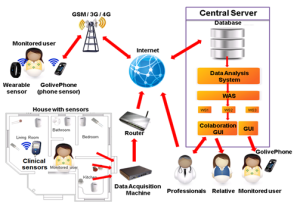The Ensafe system adapts to a variety of conditions and needs of end users, and formal and informal caregivers alike. Its flexibility permits to lower costs and serve a wider range of users.
The idea behind it is to adopt non-invasive solutions that can be effortlessly integrated to users’ lifestyles and habits, thus avoiding stressful situations and discomfort.
The devices will be integrated to a single management system and connected to a back-end server in which data will be stored, analyzed and managed.  Data will be processed through specifically developed algorithms and advanced methods in order to produce user-customized “information packages” addressing a multiplicity of purposes, to include user-profile definition, lifestyle monitoring, and identification of behavioral patterns and deviations.
Data will be processed through specifically developed algorithms and advanced methods in order to produce user-customized “information packages” addressing a multiplicity of purposes, to include user-profile definition, lifestyle monitoring, and identification of behavioral patterns and deviations.
User interfaces are designed to allow primary (patients), as well as secondary and tertiary users (informal and formal caregivers), to access user-friendly data.
The diagram on the right illustrates the architecture of the integrated system:
When a user decides to utilize the system, accepting to be monitored, different environmental sensors are installed in his/her home: wearable sensors to monitor the user’s physiological parameters. The environmental sensors detect the user’s presence and activities, such as cooking, bathroom use, TV watching, etc….
Data gathered by environmental sensors will be delivered to a small wireless calculator installed in the user’s home, while those collected by wearable sensors will be sent wirelessly to the user’s cell phone (“GoLivePhone” smartphone). Furthermore, the phone itself will function as a wearable sensor delivering information on the user’s position and other relevant facts. A central server will process data received by Internet both from the small calculator (by way of a router located in the user’s home), and the cell phone. Once in the server, all data will be stored in a database where an analysis system will process raw data transforming them into intelligent information on the user’s behavior and activities.
The analyzed data will be made available to the Web Application Server (WAS), which, through the use of Web Services (WS) and User Interface (UI), will make all information accessible to caregivers.
There will be two user interfaces:
- Collaboration Graphic User Interface, aimed at professionals and relatives, and offering a variety of interaction levels with the system;
- Graphic User Interface for primary users, which is accessible directly through the “GoLivePhone” function of a Smartphone.
In the event of significant changes to a user’s typical behavior or the identification of potentially hazardous situations, the system will alert caregivers, giving them adequate time to react.
The Ensafe Project proposes a “holistic” approach to promote an individual’s health and well-being, which, in turn, will contribute to the formulation of prevention and early diagnosis models that will allow continuous assistance aimed at improving users’ behavior. The self-sufficient elderly can now receive the support they need to live in their own homes and have a better quality of life. Our system features a flexible interpretive model suitable to manage different system configurations and adapt to users’ changing needs. The application and integrated platform will allow maximum control for end users whose data can be shared with their formal and informal caregiver network. This will also promote awareness of ethical issue and privacy protection.
The proposed system integrates a wide range of different sub-systems, technologies and services featuring multi-level complex interactions. Its architecture presents significant challenges, such as, for instance, the need to manage complexities easily and viably. Unlike old systems, which functioned independently, an ICT integration that leverages modern data merging and analysis procedures will make possible to gather new data and more accurate information on the well-being of elderly users.

 Data will be processed through specifically developed algorithms and advanced methods in order to produce user-customized “information packages” addressing a multiplicity of purposes, to include user-profile definition, lifestyle monitoring, and identification of behavioral patterns and deviations.
Data will be processed through specifically developed algorithms and advanced methods in order to produce user-customized “information packages” addressing a multiplicity of purposes, to include user-profile definition, lifestyle monitoring, and identification of behavioral patterns and deviations.